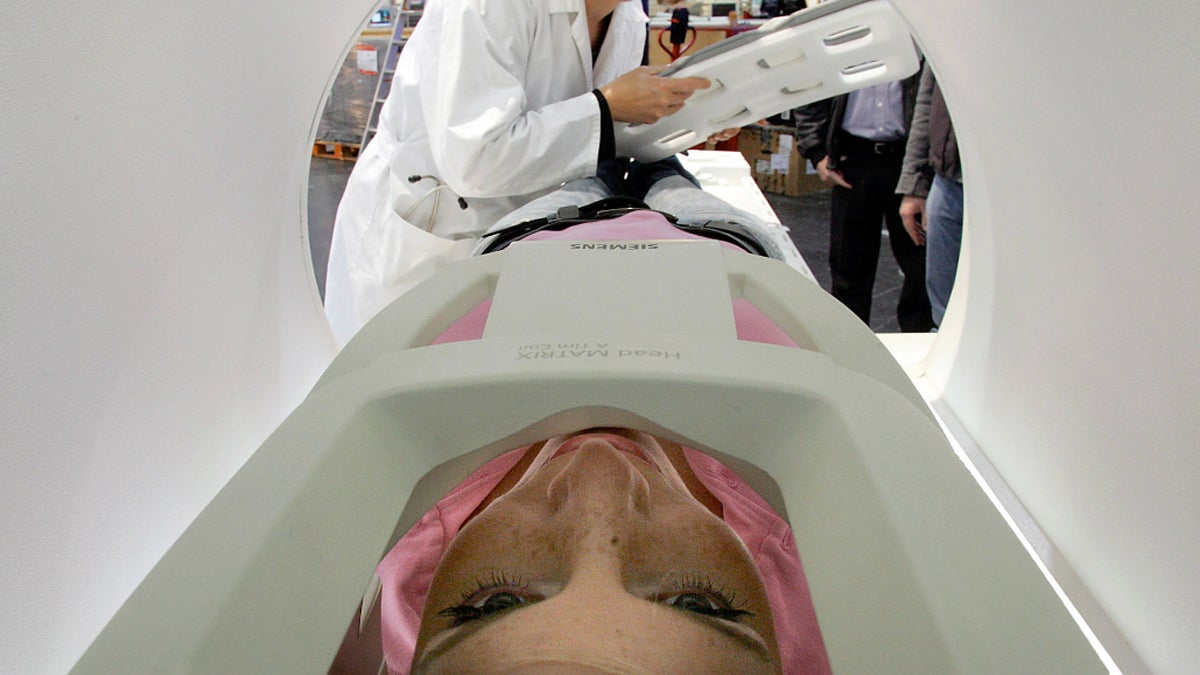The MRI is a source of anxiety — and musical inspiration
Listen
An MRI is a noisy and
It’s claustrophobic; it’s noisy. Having an MRI causes some folks anxiety. But many have found ways to cope with the test through music.
The MRI is a common medical procedure, and sometimes a life-saving one.
But to many who undergo the diagnostic test called Magnetic Resonance Imaging, the experience seems anything but normal.
You lie flat inside a cacophonous, often narrow tube for upwards of 40 minutes, under strict orders not to move a muscle.
So, you know, don’t be anxious. Just relax.
Boring, scary … or inspiring?
Most people have little problem coping with an MRI, Dr. Donald Mitchell, director of MRIs at Thomas Jefferson University Hospital, told The Pulse.
“Many say it was boring,” he said. “Many fall asleep.”
But then there are the Toniette Mordas. For her, the unanticipated clamor, emotion and enclosure created the perfect recipe for a panic attack during her first MRI in 2001.
“I had to make them stop, and I didn’t go back in,” she recalled.
In a survey of more than 10,000 patients, one imaging company found that about one in three reported some degree of distress from having to lie still in a confined space for a long time.
Morda, who has trigeminal neuralgia, a painful nerve disorder, has since undergone four more MRIs. (Whatever you do, she advises, keep your eyes closed.)
At the other end of the spectrum sit the Charlotte Gainsbourgs. The French electropop singer underwent multiple MRIs after suffering a brain hemorrhage from a water-skiing accident.
“Every time I was in that tube I was thinking it would make great music,” she told Pitchfork in 2009. So that’s what she did, on her cover track for her 2009 album “IRM” (French for MRI).
What is that noise?
An MRI uses magnetic and radio waves to scan the body and produce internal images of tissues, organs and other body parts.
“So there are similarities in the physics of it to a radio that you’ll listen to,” Mitchell said. “But instead of detecting signals from a radio station and turning it into voice or music, this is using radio waves when a person is inside a magnetic field to make sophisticated images.”
Gerry Whelan, a retired Philadelphia physician recalled his last MRI as “sort of like being in a trash can while somebody is running a jackhammer.”
Janet DeSimone of Georgia, finds it sounds “like a laundry machine with nuts and bolts in it.”
The noise itself, sometimes rhythmic, sometimes not, comes from electricity being turned on and off as it runs through coils inside the machine. The coils create secondary magnetic fields, which help technicians generate images.
When the electricity goes on and off, this causes the coils to expand and contract slightly, and that creates the noises. Quick changes in electricity, for example, may generate a humming noise, while less frequent changes, every few seconds, may create more of a knocking sound.
The Pulse spoke with many people about the experience of getting an MRI.
Here are highlights of the advice they offered on how to cope wih your time inside that noisy tube:
Relax. MRIs have no known harmful side effects.
Close your eyes before going in and try not to open them. That way you won’t feel enclosed.
Meditate. As thoughts come up, just let them go. As sounds come up, just let them be part of the breathing.
Pray.
Try to think of a journey you’ve taken or something that you love to do, and let your mind take you to that place.
Think of a song that the MRI rhythms remind you of. (See more on this one just below.)
If none of that works, you might fall into the medication category, if a doctor deems that appropriate.
The Pulse’s MRI playlist
Charlotte Gainsbourg wasn’t the only person to think musical thoughts while living through the clanging rhythms of an MRI.
Composer Mira Calix said she’d had no inkling about how loud the MRI would be before she underwent the procedure.
“It’s like standing next to a jet engine on a runway,” she told the BBC in 2009. “I’d bring a string quartet if I were ever in the machine again.”
So she reimagined the situation, set to music.
Her work with Anna Meredith, Faster than Brainwaves, is part of the Aldeburgh Music’s Faster Than Sound project.
Here are some other examples of MRI-inspired music:
This is a classic viral video among magnetic resonance imaging specialists, according to Dr. Mitchell. A group of MRI techs programmed sequences to mimic the rock classic, Smoke on the Water.
Dan Lloyd, a philosophy professor at Trinity College, converted data from functional MRI brain scans [fMRI] into musical sounds. Here’s what happened.
“IRM” [French for MRI] by Charlotte Gainsbourg.
Have you ever had an MRI? Any other tips for coping? What would you put on your listening playlist during the procedure? Tell us in the comment section below.
WHYY is your source for fact-based, in-depth journalism and information. As a nonprofit organization, we rely on financial support from readers like you. Please give today.



